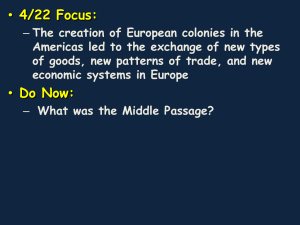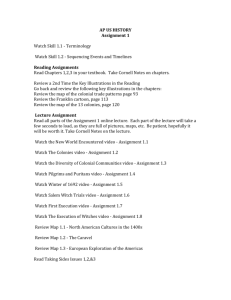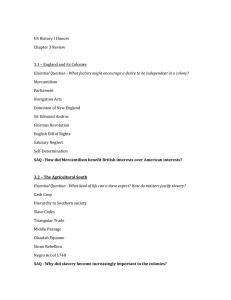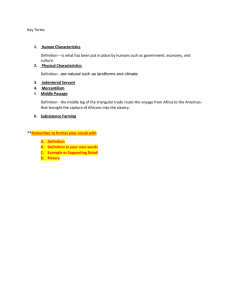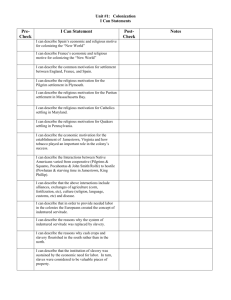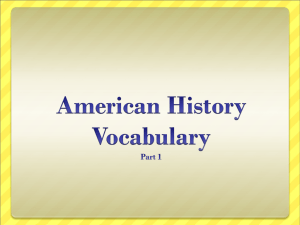Unit 1 Outline _ Questions
advertisement
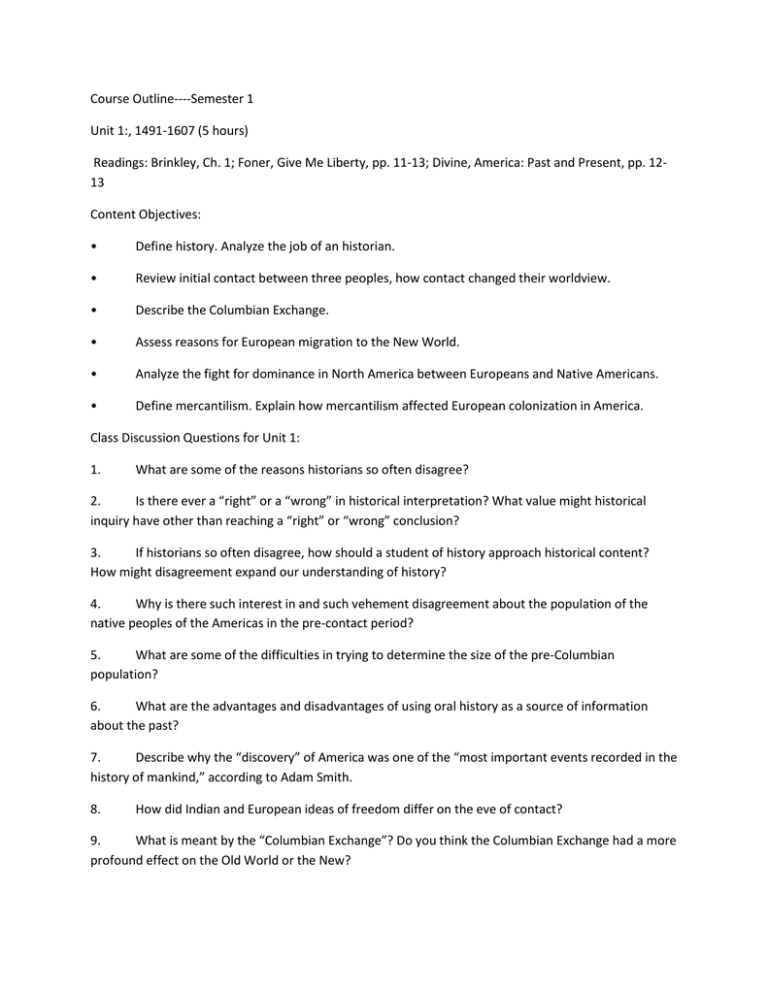
Course Outline----Semester 1 Unit 1:, 1491-1607 (5 hours) Readings: Brinkley, Ch. 1; Foner, Give Me Liberty, pp. 11-13; Divine, America: Past and Present, pp. 1213 Content Objectives: • Define history. Analyze the job of an historian. • Review initial contact between three peoples, how contact changed their worldview. • Describe the Columbian Exchange. • Assess reasons for European migration to the New World. • Analyze the fight for dominance in North America between Europeans and Native Americans. • Define mercantilism. Explain how mercantilism affected European colonization in America. Class Discussion Questions for Unit 1: 1. What are some of the reasons historians so often disagree? 2. Is there ever a “right” or a “wrong” in historical interpretation? What value might historical inquiry have other than reaching a “right” or “wrong” conclusion? 3. If historians so often disagree, how should a student of history approach historical content? How might disagreement expand our understanding of history? 4. Why is there such interest in and such vehement disagreement about the population of the native peoples of the Americas in the pre-contact period? 5. What are some of the difficulties in trying to determine the size of the pre-Columbian population? 6. What are the advantages and disadvantages of using oral history as a source of information about the past? 7. Describe why the “discovery” of America was one of the “most important events recorded in the history of mankind,” according to Adam Smith. 8. How did Indian and European ideas of freedom differ on the eve of contact? 9. What is meant by the “Columbian Exchange”? Do you think the Columbian Exchange had a more profound effect on the Old World or the New? 10. Compare and contrast European values and ways of life to those of the Indians. Be sure to look at religion, views on property ownership, gender relations, and views of freedom. 11. What is the Atlantic World? What has led historians to begin studying the idea of an Atlantic World? 12. Does studying American history in an Atlantic World context broaden or distort our understanding of American history? 13. What effect did mercantilism have on colonial economies? Did the effects differ according to which European nation owned the colony? 14. What is mercantilism and what did it have to do with the European colonization of North America? How did mercantilism contribute to power rivalries among the European nations? 15. Mercantilism as a nation’s driving economic force has largely given way to economic globalization, that is, the increased interdependence of nations’ economies. Why do you think this is so? 16. How did contact between the European arrivals and the native peoples of the Americas affect both groups? 17. How did Spanish settlement in America differ from that of the English, Dutch, and French? 18. What were the effects of the importation of African slaves into the Americas? 19. How did the English experience at colonization in Ireland affect English colonization in America? 20. How have historians’ views of Native Americans and their role in the European colonization of North America changed over time? Unit 2: Colonial History, 1607-1754 (11 hours) Readings: Brinkley, Ch. 2-3; Foner, pp. 45-47, 62-63, 92-93; Divine, pp. 86-87, 100 (9th Ed.) Content Objectives: • Compare and contrast European settlements in the Americas. • Examine the debate over the “middle ground.” • Compare and contrast New England settlements with those in the Chesapeake and the South. • Compare and contrast European concepts of land and freedom with those of Native Americans. • Describe the origins of slavery in the Americas. • Assess the affect of the Salem witchcraft trials on New England culture. • Review the Great Awakening. Class Discussion Questions for Unit 2: 1. What challenges did early English settlers face? How did Virginia and Maryland develop in their early years? 2. What were the middle grounds and how did conditions there differ from conditions in the colonies along the Atlantic seaboard? Why did the “middle ground” between Native Americans and European settlers disappear? Is there a “middle ground” in the United States today? If so, where? How is this “middle ground” similar to and different from the middle ground between Native Americans and Euro-American settlers in the seventeenth and eighteenth centuries? 3. Compare patterns of settlement and expansion in the Chesapeake with those in New England. What were the major differences? Were there any similarities? 4. The English believed that, unlike those of the Spanish, their motives for colonization were pure, and that the growth of empire and freedom would always go hand-in-hand. How did the expansion of the British empire affect the freedoms of Native Americans, the Irish, and even many English citizens? 5. What were the reasons for the revolts and rebellions that occurred in the colonies of Virginia, Maryland, Massachusetts, and New York between 1660 and 1700? How were these rebellions resolved? 6. How did the institution of slavery in England’s Atlantic seaboard colonies differ from slavery in the Caribbean? What accounted for these differences? 7. How did the Glorious Revolution in England affect England’s North American colonies? 8. What do historians say is the relationship between racism and slavery? 9. What are the economic arguments put forward by historians to explain the system of slave labor that developed in America? Do these arguments account fully for the development of slavery? 10. How was slavery established in the Western Atlantic World? Why was slavery more successful than other labor systems in meeting the labor needs of colonial America’s market economy? How did the lives of African slaves change over the course of the first century of slavery? 11. How did the Salem witchcraft trials affect attitudes toward women and the status of women in colonial New England? 12. Why were colonial New Englanders willing to believe accusations of witchcraft about their fellow colonists? What contemporary parallels are there to the Salem witchcraft trials? 13. Why were almanacs so popular in colonial America? What can almanacs tell us about life in colonial America? 14. The Farmers’ Almanac is still popular today, distributing more than 4 million copies a year. Why do you think it continues to be popular? 15. How did patterns of family life and attitudes toward women differ in the northern and southern colonies? 16. Who emigrated to North America in the seventeenth century, and why did they come? 17. What was the intellectual culture of colonial America, as expressed in literature, philosophy, science, education, and law? 18. How and why did life in the English colonies diverge from life in England? 19. How did the tobacco economy draw the Chesapeake colonies into the greater Atlantic World? 20. For the English, land was the basis of liberty. Explain the reasoning behind that concept and how it was markedly different from the Indians conception of land. 21. How did the English empire in America expand in the mid-seventeenth century? 22. How did patterns of class and gender roles change in eighteenth century America? 23. How did the Great Awakening challenge the religious and social structure of British North America?


